His paintings glow with twilight, bonfires, and blooming gardens. Rooted in the Norwegian landscape, Astrup’s art captures a world where nature, myth, and memory blend into something quietly magical.
While Edvard Munch’s The Scream is internationally recognised, few outside of Norway have heard of Nikolai Astrup.
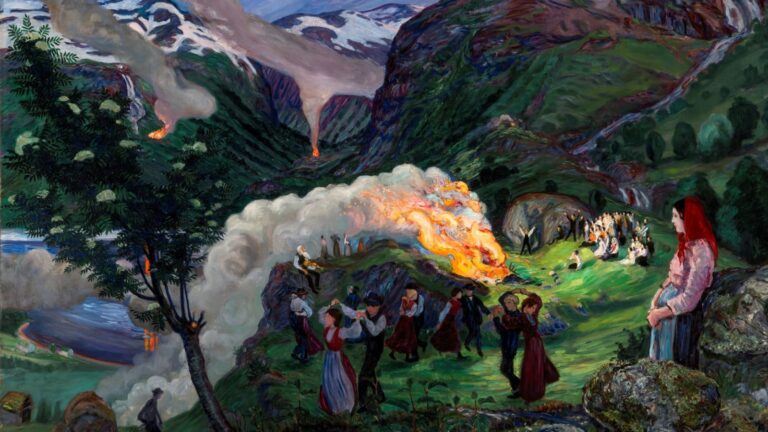
Yet within Norway, Astrup (1880–1928) is celebrated for his vivid, dreamlike depictions of rural life, steeped in local folklore and natural rhythms.
Today, decades after his death, Astrup’s work is finally reaching an international audience—and revealing a completely different side of Norwegian art.
Painting a Living Landscape
Astrup’s work is immediately recognisable for its bold use of colour, stylised forms, and emotional intensity. While Munch explored internal anguish, Astrup brought the Norwegian countryside to life with joy, mystery, and reverence.
He was particularly drawn to twilight and nighttime scenes, often inspired by his habit of walking at night to relieve asthma symptoms.
The seasons, the cycle of life, and the ever-changing quality of light in western Norway became central themes. Trees take on human form. Mountains loom with faces. His landscapes are not mere reproductions of nature, but living, breathing presences shaped by myth and memory.
In the dim twilight and in the shadow of a blazing bonfire, nature is brought to life. Trees become trolls. Mountains acquire faces
Bergen Art Museum
Folklore and Midsummer Magic
Astrup was deeply influenced by the local traditions that many in his religious community deemed ‘heathen.’ Midsummer Night, complete with bonfires, dancing, and storytelling, was one of his favourite motifs.
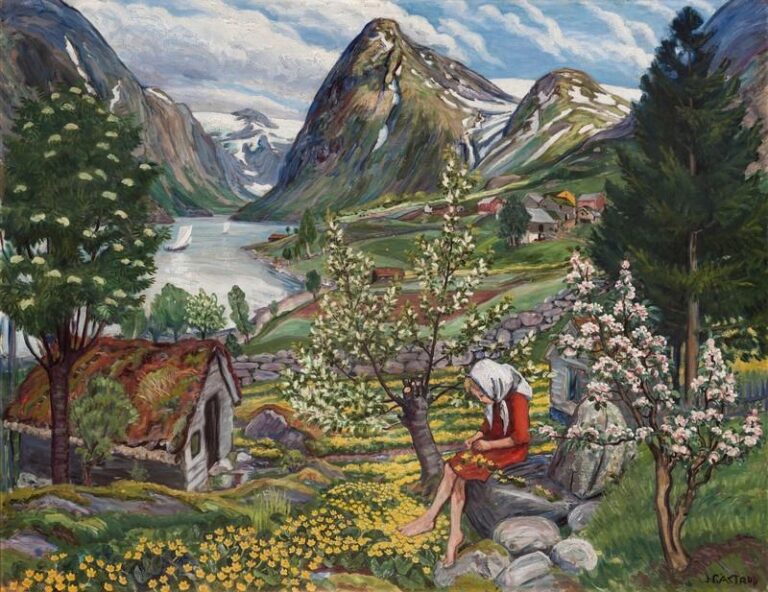
While others dismissed these customs, Astrup celebrated them, blending folklore and fantasy into his work with symbolic power.
Paintings like Midsummer Eve Bonfire capture these moments with a luminous, almost otherworldly glow. His recurring subjects such as bonfires, birch trees, and old farmsteads evoke both childhood wonder and a collective cultural memory.
Life in Rural Jølster
Nikolai Astrup was born in 1880 in the coastal village of Kalvåg in western Norway. When he was three years old, his family relocated inland to the parish of Ålhus in Jølster, a small rural community surrounded by dramatic natural beauty.
Located between the Nordfjord and Sognefjord, the region is characterised by steep mountains, glacial lakes, and fertile valleys. These landscapes left a lasting impression on Astrup and would later become central to his artistic vision.
Astrup grew up in the parish house beside Ålhus Church, where his father served as a Lutheran pastor. As the eldest son in a devout Christian household, he was expected to follow in his father’s footsteps and enter the clergy.
However, Astrup showed little interest in theology and was far more captivated by the world outside the church: the shapes of the mountains, the changing light, and the rhythms of rural life.
Despite his family's disapproval, Astrup chose to pursue a career in art. This early act of rebellion was not just personal but symbolic of a deeper divide that would run through much of his work. On one side stood the formal, religious values of his upbringing.
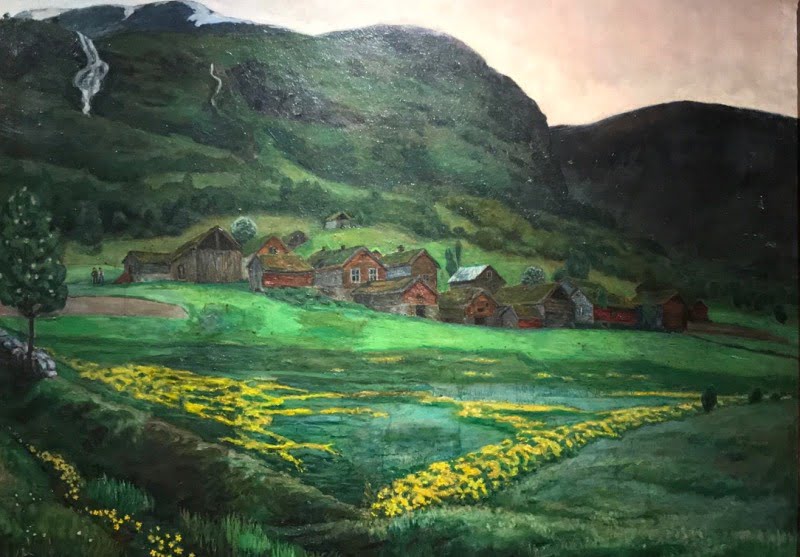
On the other, the rich traditions of folklore, seasonal festivals, and the mystical qualities of nature that surrounded him. Jølster provided both the physical setting and emotional tension that shaped his life’s work.
From Kristiania to Paris
Nikolai Astrup began his art education in 1899 at the Harriet Backer School in Kristiania (now Oslo), where he developed a strong foundation in naturalistic painting and connected with several key figures in Norwegian art.
He later studied under Christian Krohg, whose focus on rural life and ordinary people aligned closely with Astrup’s own interests.
To expand his artistic horizons, Astrup travelled to Berlin, London, and Paris in the early 1900s. There, he encountered Symbolism, Art Nouveau, and European Expressionism, all of which influenced his evolving style.
Although he admired artists like Paul Gauguin, Astrup remained deeply connected to Norway. He chose not to follow international trends, but instead returned home to cultivate a personal style rooted in the natural beauty, seasonal rhythms, and folk traditions of Jølster.
His travels broadened his perspective, but it was the familiar landscapes of western Norway that continued to inspire his work.
Woodcuts and Late Style
Although criticised by some for a lack of stylistic innovation, Astrup experimented in his later years with colour woodcuts, a relatively rare medium in Norway at the time.
Inspired by Japanese ukiyo-e prints and German expressionist techniques, Astrup produced multi-layered prints that are now considered among the most original in Norwegian art history.
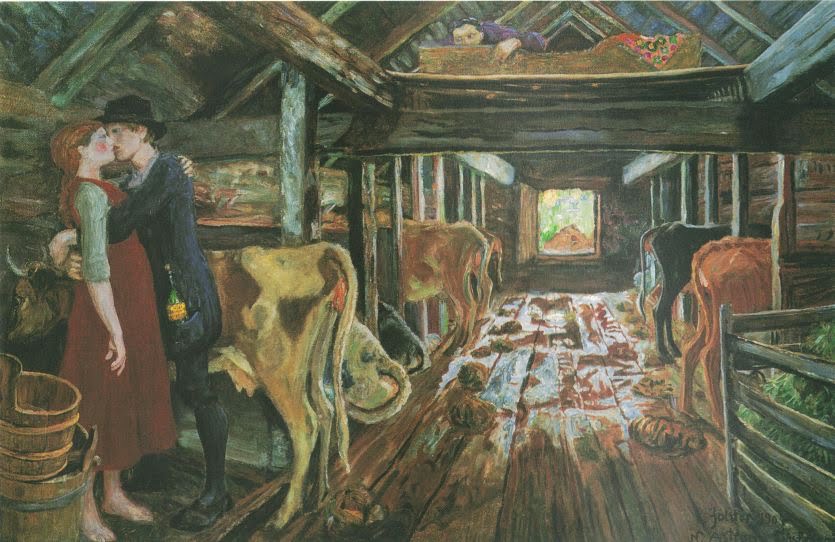
His later work also incorporated lighter palettes and more abstract forms, while still rooted in the familiar landscapes of Jølster.
Death and Rediscovery
Astrup died young, at just 47, from complications related to pneumonia. During his life, he was respected in Norway but never achieved the same fame as Munch.
It wasn’t until 2016 that Astrup’s work received a major international exhibition. London’s Dulwich Picture Gallery presented Painting Norway, featuring over 90 works, including many never seen outside Norway. The Guardian hailed the show as a revelation:
He should be as famous as Edvard Munch, but the world seems to have forgotten him, until now. Astrup is getting his first major show outside Norway… and his visions of the Scandinavian landscape are eerie and sublime
The Guardian
Where to See His Work Today
Although Nikolai Astrup never achieved international fame during his lifetime, his legacy lives on in two remarkable Norwegian institutions that allow visitors to experience his art in the very landscapes that inspired it.
Astruptunet, Jølster: Step Into Astrup’s Painted World
For those truly seeking to understand Nikolai Astrup’s art, there is no better place to begin than Astruptunet, the artist’s former home and studio in Sandalstrand near Ålhus in Jølster. It's typically open from May to September.
Perched on a steep hillside overlooking the lake Jølstravatnet, the site offers sweeping views of the very landscapes that appear again and again in Astrup’s paintings.
Astrup and his wife Engel painstakingly designed the terraced gardens surrounding the house, planting fruit trees, vegetables, and vibrant flowers. These gardens were not only a source of sustenance but also a living canvas, often featured in his works such as Rhubarb and Foxgloves.
Today, visitors can stroll through these same gardens, explore the rustic wooden buildings Astrup called home, and view a rotating display of his original artworks.
The museum also hosts guided tours and seasonal exhibitions, making Astruptunet both a cultural destination and a deep immersion into the rhythms of rural Norwegian life. Visiting feels like stepping inside an Astrup painting, complete with the birdsong, breeze, and shifting light he so carefully captured.
KODE Art Museums, Bergen: A Comprehensive Collection
For a year-round, urban encounter with Astrup’s art, the KODE Art Museums in Bergen offer the most comprehensive public collection of his works.
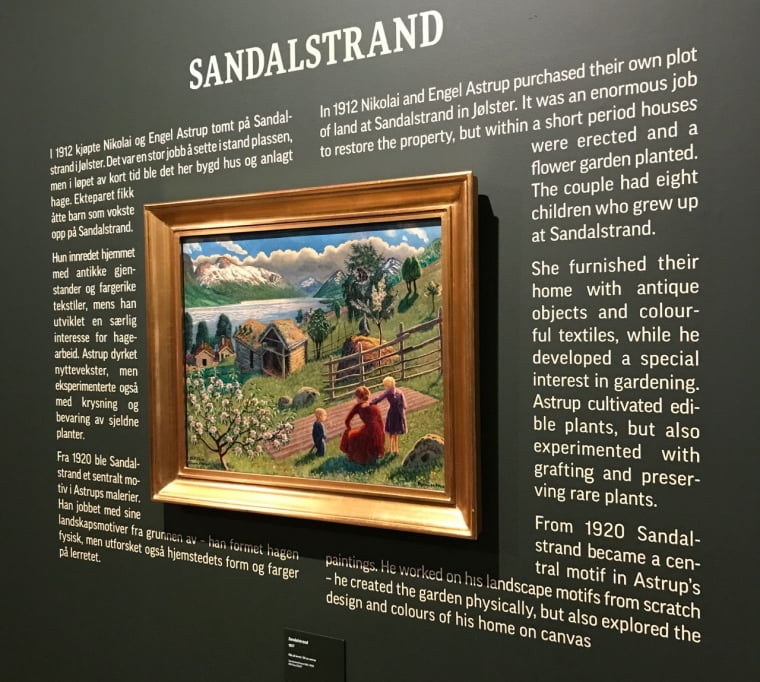
Located in the city centre by the scenic Lille Lungegårdsvann lake, KODE is one of Scandinavia’s largest art museum groups, and Astrup features prominently in its permanent collection.
The museum’s Astrup gallery not only displays a wide range of paintings and colour woodcuts, but also provides rich context about his influences, techniques, and personal life.
The curators pay special attention to his unique artistic process, including his rare use of multiple woodblocks and hand-colouring techniques, which set his prints apart.
The museum also explores Astrup’s position in Norwegian art history alongside other greats like Edvard Munch, Theodor Kittelsen, and Harriet Backer, offering valuable insight into his legacy and belated international recognition.
A New Light on Norwegian Art
Today, Astrup is gaining the recognition he long deserved. His work doesn’t just depict Norway, it distills its spirit: the glow of a summer bonfire, the shimmer of a midnight lake, the whispers of the forest.
For those willing to look beyond Munch, Nikolai Astrup offers a luminous, enchanted vision of the Norwegian soul.


Totally agree – a very under appreciated artist. The Astrup display at KODE in Bergen is fantastic. The colour and vibrancy of the landscape work is superb…well worth a visit when in the city.
Impressive..good colours.
Will look for his work when next in Norway.Bergen is the spot I see.
These images jump off the canvas, what colors! Norway showing her True Colors through this artist….l.l..
I wonder if this attention as something to do with being referenced in Knausgard’s book.